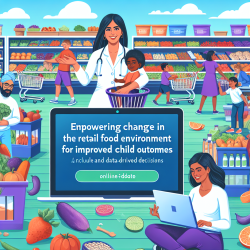Introduction
Practitioners working with children affected by HIV/AIDS face unique challenges in addressing both health and economic barriers. The study titled "Evaluation of a savings-led family-based economic empowerment intervention for AIDS-affected adolescents in Uganda: A four-year follow-up on efficacy and cost-effectiveness" offers valuable insights into how economic empowerment can significantly improve health outcomes among adolescents. This blog aims to translate these findings into practical strategies for practitioners, emphasizing the importance of data-driven decisions in enhancing child development.
Understanding the Intervention
The study evaluated the "Bridges" intervention, which included two savings-led treatment arms: Bridges and BridgesPLUS. These interventions provided AIDS-orphaned adolescents with incentivized savings accounts, financial literacy training, and mentorship. The goal was to improve self-rated health, mental health functioning, and HIV knowledge while assessing cost-effectiveness.
Key Findings
- Health Improvements: Both Bridges and BridgesPLUS significantly enhanced self-rated health and HIV knowledge compared to usual care. BridgesPLUS also reduced hopelessness and improved self-concept and self-efficacy.
- Cost-Effectiveness: The incremental cost-effectiveness ratios (ICERs) indicated that BridgesPLUS had a lasting effect on multiple outcomes at a similar cost per unit effect as Bridges.
- Long-Term Impact: The effects were sustained two years post-intervention, suggesting that higher matching incentives yield more significant and lasting benefits.
Implications for Practitioners
Practitioners can leverage these findings to advocate for and implement similar economic empowerment interventions in their practice. Here are some strategies:
- Incorporate Financial Literacy: Integrate financial education into therapy sessions to empower adolescents with skills that promote long-term health and economic stability.
- Advocate for Policy Changes: Use the study's data to support policy changes that incorporate economic empowerment interventions into national social protection frameworks.
- Collaborate with Financial Institutions: Partner with banks and financial organizations to provide adolescents with access to savings accounts and financial incentives.
Encouraging Further Research
While the study provides robust evidence of the benefits of economic empowerment interventions, further research is needed to explore additional outcomes and settings. Practitioners are encouraged to contribute to this growing body of knowledge by conducting studies in different contexts and populations.
Conclusion
Economic empowerment interventions, such as the Bridges program, offer a promising approach to improving health outcomes for adolescents affected by HIV/AIDS. By integrating these strategies into practice, practitioners can create meaningful, long-lasting impacts on child development. To read the original research paper, please follow this link: Evaluation of a savings-led family-based economic empowerment intervention for AIDS-affected adolescents in Uganda: A four-year follow-up on efficacy and cost-effectiveness.










